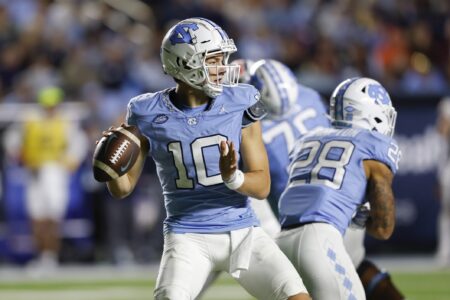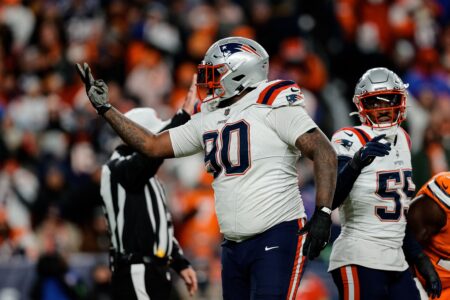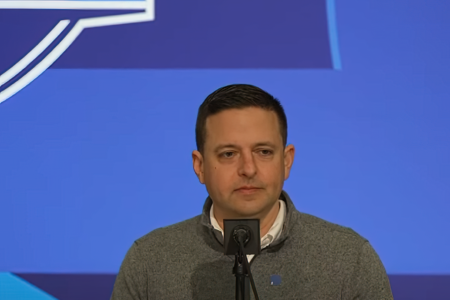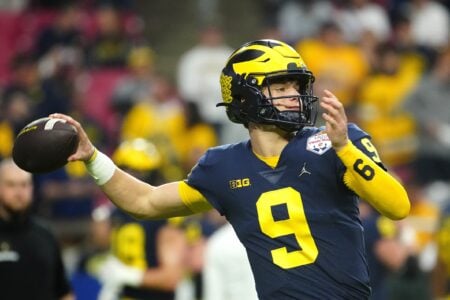- Joined
- Sep 17, 2009
- Messages
- 11,575
- Reaction score
- 11,408
Disclaimer: The game is played on the field. This is literally the outcome of ****ing with numbers, so take it for what it's worth.
The "TL;DR version" first (a more "detailed" explanation and a summary of the methodology below):
Ever since the Pats and Falcons punched their ticket to the Super Bowl, I've been making a mantra of my prediction; 31-23. I freely admitted that it was just a hunch. But I wanted to dig into the numbers, just to see if they undercut the media narratives following the Championship Games. The results were surprising to me.
The general idea was that I looked at the performances of each skill player on offense and how their performances varied according to the skill level of the defenses they faced. Since players on both teams demonstrated reliable adjustments according the defenses they faced, this was a somewhat easier process.
The final output is how player averages would look against a defenses of the caliber each will face in the Super Bowl (i.e. how Ryan, Jones, and company fared against comparable defenses to what the Pats have). The following are the projected stats:
Brady
26/38, 67.8%, 326 yards, 3TD, 0INT
Blount
17 carries, 153 yards, 1TD
Edelman
9rec, 109 yards, 1TD
------------------------
Ryan
21/33, 64.4%, 288 yards, 2TD, 1INT
Coleman
9 carries, 48 yards
Jones
8rec, 129 yards, 1TD
------------------------
PATRIOTS 37 | 7 10 13 7
FALCONS 17 | 3 7 7 0
------------------------
Basic Methodology
I'm not going to get into the weeds a whole lot, but the basic idea was to try and gauge how each team would do in the Super Bowl by breaking down their past performances at the lowest level possible. So instead of focusing on yards per game, or points per game, I started with the premise of yards per play per player. In the passing game, this meant yards per attempt, in the rushing game, this meant yards per carry, and in the receiving game, this meant yards per target (not reception).
After looking at a game-by-game breakdown of how each team performed, I analyzed the defense they faced while compiling those yards per play. To make a direct comparison, I looked at the yards per play for each defense they faced. I then calculated the deviation from the defense numbers; whether each player performed better or worse than what the defense usually allows.
I noticed both Brady and Ryan performed markedly better against teams they faced a second time. Because this is the first time these two teams are playing, the second game was removed from the analytic process. I limited this change to the quarterbacks only, based on the assumption that a critical factor for the better performances was a better pre-snap read of the opposing defense. Interestingly, this helped the overall stats of each quarterback, because while they improved game-over-game, those games were still below average performances.
From there, I needed to find the passing and rushing defenses that most approximated what each team will face on Sunday. I wanted 5-7 games for each player if at all possible. In some cases, such as Dion Lewis, the sample size is smaller, for which I allowed greater deviation during my adjustments. After isolating these games, I compared each player's yards per play against those defenses, took the difference (positive or negative) and then added those to what the opposing defense usually allows. I then multiplied that by the number of touches to get the stat lines for each skill player I evaluated.
Of course, both teams have role players that may take yards, catches, etc from the primary players I analyzed. During my analysis, it seemed much more likely that this would be the case with the Patriots, despite the fact that I included four WRs plus a TE in the analysis, compared to three WRs and a TE for the Falcons.
I started to whittle down these numbers further according to each team's YAC stats. However, it became quickly apparent that the yards per play on both offense and defense appeared to reflect each teams strengths and weaknesses when it comes to YAC.
After getting each player's individual totals, I reconciled the tallies of the RBs, WRs, and TEs with the QB stat line. After including the carries, I totaled the yards for each team. By this point, I already know how many TDs to expect, but I needed to compare the total yards to the yards per point allowed by each defense to account for how many field goals we might expect on top of those touchdowns.
A total stat breakdown:
Brady: 26/38, 67.8%, 326 yards, 3TD, 0INT
Blount: 17 carries, 153 yards, 1TD
Lewis: 12 carries, 53 yards
Edelman: 9rec, 109 yards, 1TD
Hogan: 4rec, 84 yards
Bennett: 4rec, 41 yards, 1TD
White: 3rec, 31 yards, 1TD
Mitchell: 3rec, 21 yards
Lewis: 2rec, 23 yards
Amendola: 1rec, 17 yards
TOTAL OFFENSE: 532 yards
------------------------
Ryan: 21/33, 64.4%, 288 yards, 2TD, 1INT
Coleman: 9 carries, 48 yards
Freeman: 12 carries, 38 yards
Jones: 8rec, 129 yards, 1TD
Gabriel: 3rec, 53 yards
Sanu: 4rec, 36 yards, 1 TD
Freeman: 2rec, 34 yards
Coleman: 2rec, 11 yards
Toilolo: 2rec, 25 yards
TOTAL OFFENSE: 374 yards
The "TL;DR version" first (a more "detailed" explanation and a summary of the methodology below):
Ever since the Pats and Falcons punched their ticket to the Super Bowl, I've been making a mantra of my prediction; 31-23. I freely admitted that it was just a hunch. But I wanted to dig into the numbers, just to see if they undercut the media narratives following the Championship Games. The results were surprising to me.
The general idea was that I looked at the performances of each skill player on offense and how their performances varied according to the skill level of the defenses they faced. Since players on both teams demonstrated reliable adjustments according the defenses they faced, this was a somewhat easier process.
The final output is how player averages would look against a defenses of the caliber each will face in the Super Bowl (i.e. how Ryan, Jones, and company fared against comparable defenses to what the Pats have). The following are the projected stats:
Brady
26/38, 67.8%, 326 yards, 3TD, 0INT
Blount
17 carries, 153 yards, 1TD
Edelman
9rec, 109 yards, 1TD
------------------------
Ryan
21/33, 64.4%, 288 yards, 2TD, 1INT
Coleman
9 carries, 48 yards
Jones
8rec, 129 yards, 1TD
------------------------
PATRIOTS 37 | 7 10 13 7
FALCONS 17 | 3 7 7 0
------------------------
Basic Methodology
I'm not going to get into the weeds a whole lot, but the basic idea was to try and gauge how each team would do in the Super Bowl by breaking down their past performances at the lowest level possible. So instead of focusing on yards per game, or points per game, I started with the premise of yards per play per player. In the passing game, this meant yards per attempt, in the rushing game, this meant yards per carry, and in the receiving game, this meant yards per target (not reception).
After looking at a game-by-game breakdown of how each team performed, I analyzed the defense they faced while compiling those yards per play. To make a direct comparison, I looked at the yards per play for each defense they faced. I then calculated the deviation from the defense numbers; whether each player performed better or worse than what the defense usually allows.
I noticed both Brady and Ryan performed markedly better against teams they faced a second time. Because this is the first time these two teams are playing, the second game was removed from the analytic process. I limited this change to the quarterbacks only, based on the assumption that a critical factor for the better performances was a better pre-snap read of the opposing defense. Interestingly, this helped the overall stats of each quarterback, because while they improved game-over-game, those games were still below average performances.
From there, I needed to find the passing and rushing defenses that most approximated what each team will face on Sunday. I wanted 5-7 games for each player if at all possible. In some cases, such as Dion Lewis, the sample size is smaller, for which I allowed greater deviation during my adjustments. After isolating these games, I compared each player's yards per play against those defenses, took the difference (positive or negative) and then added those to what the opposing defense usually allows. I then multiplied that by the number of touches to get the stat lines for each skill player I evaluated.
Of course, both teams have role players that may take yards, catches, etc from the primary players I analyzed. During my analysis, it seemed much more likely that this would be the case with the Patriots, despite the fact that I included four WRs plus a TE in the analysis, compared to three WRs and a TE for the Falcons.
I started to whittle down these numbers further according to each team's YAC stats. However, it became quickly apparent that the yards per play on both offense and defense appeared to reflect each teams strengths and weaknesses when it comes to YAC.
After getting each player's individual totals, I reconciled the tallies of the RBs, WRs, and TEs with the QB stat line. After including the carries, I totaled the yards for each team. By this point, I already know how many TDs to expect, but I needed to compare the total yards to the yards per point allowed by each defense to account for how many field goals we might expect on top of those touchdowns.
A total stat breakdown:
Brady: 26/38, 67.8%, 326 yards, 3TD, 0INT
Blount: 17 carries, 153 yards, 1TD
Lewis: 12 carries, 53 yards
Edelman: 9rec, 109 yards, 1TD
Hogan: 4rec, 84 yards
Bennett: 4rec, 41 yards, 1TD
White: 3rec, 31 yards, 1TD
Mitchell: 3rec, 21 yards
Lewis: 2rec, 23 yards
Amendola: 1rec, 17 yards
TOTAL OFFENSE: 532 yards
------------------------
Ryan: 21/33, 64.4%, 288 yards, 2TD, 1INT
Coleman: 9 carries, 48 yards
Freeman: 12 carries, 38 yards
Jones: 8rec, 129 yards, 1TD
Gabriel: 3rec, 53 yards
Sanu: 4rec, 36 yards, 1 TD
Freeman: 2rec, 34 yards
Coleman: 2rec, 11 yards
Toilolo: 2rec, 25 yards
TOTAL OFFENSE: 374 yards
Last edited:

















